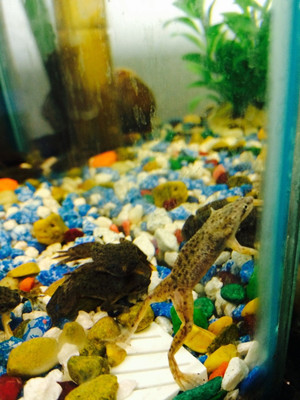The African Dwarf Frog
Posted by Max Gandara on on 8th Aug 2023
A small, captivating creature that often goes unnoticed, the African Dwarf Frog (Hymenochirus spp.) holds a special place in the realm of
aquatic life. Originating from the tropical regions of Central and West
Africa, these frogs have found their way into the hearts of many
aquarium enthusiasts around the world. Their unique characteristics,
behavior, and care requirements make them a popular choice for both
novice and experienced keepers.
African Dwarf Frogs are petite amphibians, typically growing to around
1.5 to 2.5 inches (3.8 to 6.4 cm) in length. They possess distinct
physical features that set them apart from other frog species. Their
skin is smooth and moist, and they come in a variety of colors,
including shades of olive green, brown, and even albino forms. One of
their most noticeable features is their webbed hind feet, perfectly
adapted for life in the water.
Unlike many frogs, African Dwarf Frogs are entirely aquatic creatures.
They live their entire lives underwater, rarely venturing out onto land.
They're found in slow-moving bodies of water such as streams, ponds,
and marshes in their natural habitat. In captivity, they're usually
housed in aquariums with clean water and plenty of hiding spots.
African Dwarf Frogs are social animals that prefer to live in groups.
Keeping them in pairs or small groups is recommended to provide them
with a more natural and interactive environment. They are generally
peaceful and can be kept alongside other peaceful aquatic species like
fish and shrimp, as long as the tank is well-maintained and adequately
sized.
Feeding African Dwarf Frogs is relatively easy. They are carnivorous
creatures that consume a diet consisting of live or frozen foods such as
brine shrimp, bloodworms, and daphnia. Some commercially available frog
pellets can also be included in their diet. Their feeding habits are
entertaining to watch, as they use their keen vision and quick reflexes
to snatch their prey from the water's surface.
Providing proper care for African Dwarf Frogs is crucial to their well-being. Here are some key care considerations:
1. Tank Setup: A well-filtered aquarium with a capacity of at least
10 gallons is recommended for a pair of African Dwarf Frogs. The water
temperature should be maintained between 72 to 78 degrees Fahrenheit (22
to 26 degrees Celsius).
2. Substrate: Smooth gravel or sand substrate is ideal to prevent injuries to their delicate underbellies.
3. Hiding Places: Include various hiding spots like live or
artificial plants, caves, and decorations to create a secure
environment.
4. Lighting: Low to moderate lighting levels are best, as too much light can stress these nocturnal creatures.
5. Water Quality: Regular water changes and proper filtration are
essential to maintain good water quality. Chlorine and chloramine should
be removed from tap water before use.
6. Feeding: Feed them a variety of live and frozen foods to ensure a
balanced diet. Avoid overfeeding to prevent water pollution.
African Dwarf Frogs are known for their unique reproductive behaviors.
Unlike many amphibians, they lay their eggs underwater, attaching them
to aquatic plants or other surfaces. The male fertilizes the eggs
externally, and the female guards them until they hatch into tadpoles.
The tadpoles then undergo metamorphosis into fully developed frogs.
The African Dwarf Frog's intriguing aquatic lifestyle, social nature,
and ease of care have made it a beloved choice among amphibian
enthusiasts. While they may not be as flashy as some other aquatic
creatures, their endearing behaviors and distinctive characteristics
make them a fascinating addition to any aquarium. Providing them with a
suitable environment and diet will ensure that these captivating
creatures thrive and bring joy to their keepers for years to come.

